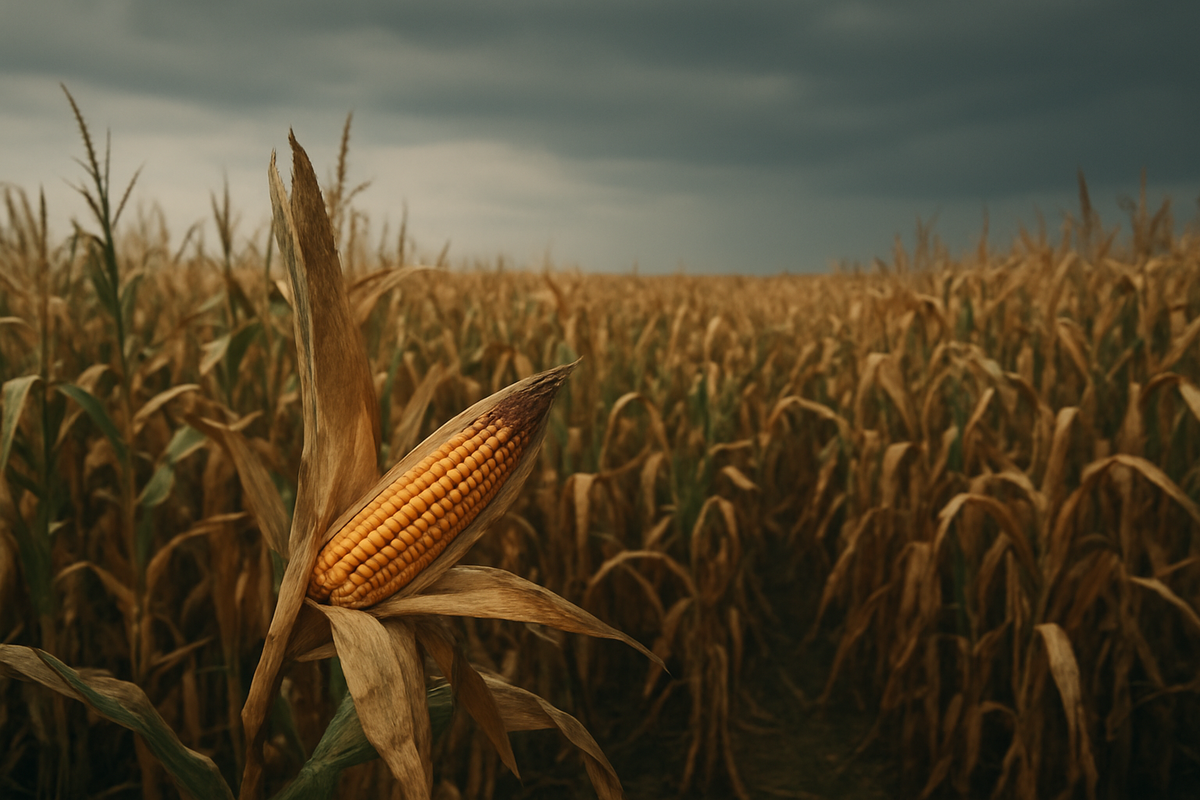
As of November 21, 2025, the global corn market is experiencing a "tepid rally," a modest upward price movement struggling against a prevailing bearish sentiment. This subdued performance, characterized by limited gains despite occasional upticks, points to a challenging environment for agricultural commodities, primarily driven by robust global supplies and a "cost-price squeeze" impacting producers. The immediate implication is a reinforcement of the bearish outlook for corn prices, with significant ramifications for farmers, agricultural input suppliers, and the broader food and biofuel industries.
The current market dynamic suggests that while temporary factors may offer brief moments of price appreciation, the underlying fundamentals of ample supply continue to cap any sustained bullish momentum. This situation is compelling stakeholders across the agricultural value chain to reassess strategies, focusing on efficiency, risk management, and diversification to navigate an environment where lower prices and high production costs are becoming the norm.
A Rally Without Conviction: Unpacking Corn's Weak Performance
The "tepid rally" in corn prices has been a defining characteristic of the market since mid-August 2025. While there have been periods of recovery, such as in late October and early November when corn futures briefly traded above $4.30 per bushel, these gains have consistently been short-lived. Often, positive movements were met with profit-taking or declines following the release of key reports. For instance, December 2025 corn futures were noted at $4.30 a bushel on November 16th, but by November 20, 2025, March corn futures had dipped by 2¾ cents, settling at $4.38¾ per bushel. The December 2025 contract is also priced 13.75 cents lower than the March 2026 contract, a classic bearish indicator for old crop corn demand.
Several factors have contributed to this weakness:
- Abundant Global Supplies: A near-record U.S. harvest, nearing completion, is a primary driver. The U.S. domestic corn production is forecast at an astounding 16.752 billion bushels, exceeding previous records, with high yields of 186 bushels per acre. Brazilian corn production was also raised to 136 million metric tons (MMT) for 2024/2025.
- USDA WASDE Report: The November 14, 2025, USDA World Agricultural Supply and Demand Estimates (WASDE) report, delayed due to a government shutdown, proved less bullish than anticipated. While corn yield was marginally lowered, ending stocks were simultaneously raised by 44 million bushels to 2.154 billion bushels, solidifying the narrative of ample supply.
- Heavy Brazilian Exports: Continued robust corn exports from Brazil, with large shipments expected in November, further contribute to the global supply glut.
- Reduced U.S. Export Competitiveness: Broader trade patterns, including China's preference for South American origins, impact the competitiveness of U.S. agricultural exports.
- Seasonality: Historically, corn prices tend to peak in early June and bottom out in early October, suggesting the current period is not typically conducive to strong rallies.
Key players and stakeholders involved in this market dynamic include farmers and producers, who are directly impacted by price fluctuations; grain elevators and processors; major exporters like the United States, Brazil, and Argentina; and large importers such as China, Mexico, and the European Union. Commodity traders and speculators also play a significant role in price discovery, while the U.S. Department of Agriculture (USDA) reports are pivotal in shaping market direction. The biofuel industry, especially ethanol producers, represents a major demand segment for corn. Initial market reactions have been cautious, with farmer sentiment leaning towards financial strain and traders engaging in "buy the rumor, sell the fact" behavior, leading to quick profit-taking.
Corporate Fortunes: Winners and Losers in a Bearish Corn Market
The prevailing bearish outlook for corn prices creates a clear divide among public companies, benefiting those that consume corn as a raw material while challenging those whose profitability relies on higher corn prices or supplying inputs to farmers. With March corn futures around $4.38¾ per bushel and the USDA projecting the 2025-26 season-average price to fall to $3.90 per bushel, this market condition will reshape corporate strategies and financial performance.
Companies Likely to Lose:
- Agricultural Input Suppliers: Companies providing seeds, fertilizers, and agrichemicals face significant headwinds. Farmers, grappling with low corn prices and high input costs, are reducing spending. This translates to reduced demand and pressure on sales volumes and margins for companies like Corteva, Inc. (NYSE: CTVA), Bayer AG (XETRA: BAYN), Nutrien Ltd. (NYSE: NTR), CF Industries Holdings, Inc. (NYSE: CF), and The Mosaic Company (NYSE: MOS).
- Agricultural Equipment Manufacturers: Lower farm income directly curtails capital expenditures on new machinery. Companies such as Deere & Company (NYSE: DE), AGCO Corporation (NYSE: AGCO), and CNH Industrial N.V. (NYSE: CNHI) are expected to see reduced sales volumes, with farmers opting for maintenance or used equipment. Deere, for example, is projected to see a 15% decline in agricultural machinery revenue in 2025.
Companies Likely to Win (or Benefit):
- Food Processors and Consumer Packaged Goods (CPG) Companies: These firms benefit from lower corn prices, as corn and its derivatives (e.g., high-fructose corn syrup, cornstarch) are key raw materials. Reduced commodity costs can significantly lower their cost of goods sold, potentially improving gross profit margins. This includes major players like Archer-Daniels-Midland Company (NYSE: ADM), Bunge Global SA (NYSE: BG), General Mills, Inc. (NYSE: GIS), Post Holdings, Inc. (NYSE: POST), PepsiCo, Inc. (NASDAQ: PEP), and The Coca-Cola Company (NYSE: KO).
- Grain Traders/Processors: Companies involved in buying, storing, transporting, and processing large volumes of grain stand to benefit from abundant corn supplies. Even with tighter per-bushel margins, increased volume can lead to higher overall revenues and profits. Archer-Daniels-Midland Company (NYSE: ADM) and Bunge Global SA (NYSE: BG) are prime examples, benefiting from their extensive trading and processing operations. The Andersons, Inc. (NASDAQ: ANDE) also engages in grain merchandising and risk management.
- Meat and Poultry Producers: Corn is a primary component of animal feed, so lower corn prices directly reduce production expenses for livestock, poultry, and dairy producers. This significantly improves their profitability. Companies like Tyson Foods, Inc. (NYSE: TSN), Pilgrim's Pride Corporation (NASDAQ: PPC), and Cal-Maine Foods, Inc. (NASDAQ: CALM) are strong beneficiaries.
- Ethanol Producers: As corn is the primary feedstock for ethanol, lower corn prices generally translate to reduced raw material costs. This can enhance the profitability of ethanol plants, provided ethanol demand and prices remain stable. Green Plains Inc. (NASDAQ: GPRE), Valero Energy Corporation (NYSE: VLO) (through Valero Renewable Fuels), and Archer-Daniels-Midland Company (NYSE: ADM) with its significant ethanol operations, are positioned to benefit.
Wider Implications: A Shift in the Agricultural Landscape
The bearish outlook in corn prices is not an isolated event but rather a significant indicator of broader shifts within the agricultural commodities industry. It underscores a pervasive trend of global oversupply across the grain complex, exacerbated by persistently high input costs for farmers, creating a severe "cost-price squeeze." This dynamic is expected to decelerate global consumption growth over the next decade, with most additional demand projected from low- and middle-income countries.
The ripple effects extend across the entire agricultural ecosystem. Farmers, facing projected net losses for 2025, are under immense financial stress. This will likely lead to strategic planting shifts for the 2026 season, with some potentially reducing corn acreage in favor of other crops or diversifying into specialty crops, thereby impacting the supply of other commodities. While grain processors and the food industry benefit from reduced raw material costs, agricultural input suppliers and equipment manufacturers will face reduced demand and compressed margins. The livestock industry, however, will enjoy improved profitability due to lower feed costs.
Regulatory and policy implications are also significant. The financial distress of farmers is expected to increase reliance on government support, with direct government payments projected to reach $42.4 billion in 2025, potentially the second highest on record. This situation will likely fuel calls for sustained or increased farm subsidies. Biofuel mandates, particularly the Renewable Fuel Standard (RFS), remain a critical demand driver for corn. Proposed changes to RFS quotas and tax credits favoring North American inputs could create new demand, but debates persist regarding the efficacy and impact of these mandates.
Historically, the current bearish market shares similarities with past agricultural downturns characterized by oversupply cycles, such as the period from 2018-2019 and the post-2012 decline. The projected 90 million acres of corn harvested in 2025 is the most since 1933, an era also marked by agricultural overproduction. This suggests a potential return to a multi-year period of lower prices, with the high prices between 2021 and 2023 increasingly viewed as a transitory period driven by short-term factors.
What Lies Ahead: Navigating Volatility and Strategic Shifts
The corn market, currently navigating a tepid rally within a bearish framework, faces a future defined by continued volatility and the necessity for strategic adaptation across all stakeholder groups. Short-term possibilities (next 3-12 months) suggest corn prices trading around 433.83 US cents/bushel by the end of Q4 2025, potentially reaching 458.99 US cents/bushel in 12 months. However, significant price volatility (up to 15%) is anticipated, heavily influenced by South American weather patterns, which have already seen delayed plantings in Argentina and easing dryness in Brazil.
Long-term possibilities (1-5 years and beyond) indicate that corn prices may stabilize around $4.25-$4.55 per bushel, reminiscent of the 2015-2019 period, though remaining susceptible to climate, trade, or policy shocks. The global corn market is projected to experience substantial growth, driven by sustained demand from animal feed, biofuel blending mandates, and starch-based industrial applications, particularly with global shifts towards higher-protein diets and innovations in high-yield hybrids.
Strategic pivots are crucial for survival and prosperity. Farmers, facing projected net losses, must adopt enhanced risk management strategies, including hedging tools and exploring acreage shifts to more profitable crops for the 2026 season. Cost efficiency and the adoption of precision agriculture technologies will be paramount. Agricultural equipment manufacturers will need to adapt to reduced sales, focusing on aftermarket services or offering financing. Grain processors and millers, however, may find the lower grain prices favorable for their operations.
Market opportunities include the expanding biofuel sector, particularly with the U.S. Inflation Reduction Act mandating a 50% increase in biofuel blending by 2030, which could consume 42% of U.S. corn production by 2025. A resurgence in export demand, especially from China, or new trade deals, could also provide significant upside. Domestic demand for animal feed and industrial applications remains robust. Challenges, however, persist in the form of persistent global oversupply, U.S. export competitiveness against South American producers, stubbornly high input costs, and potential trade wars or policy exemptions that could depress prices.
Potential scenarios range from a volatile/neutral outcome, where prices remain range-bound, to continued bearish pressure leading to deeper financial strain for farmers. An upside potential exists from significant supply shocks due to adverse weather, particularly in South America, or unexpected global events. Conversely, increased acreage with high yields could further exacerbate oversupply, potentially driving prices below $4 per bushel.
A New Era for Corn: Navigating Abundance and Uncertainty
The "tepid rally" and persistent bearish outlook in the corn market as of November 21, 2025, mark a significant juncture for the agricultural sector. The era of robust grain prices seen in recent years appears to be giving way to a period of sustained lower returns for crop producers, defined by an "era of abundance" in corn supplies and a "cost-price squeeze" for farmers. This situation, characterized by projected net losses for many U.S. corn farmers for the third consecutive year, underscores deeper structural challenges within the industry.
Moving forward, the market will likely remain volatile, with prices influenced by a complex interplay of global supply and demand dynamics, macroeconomic factors, and geopolitical developments. While robust domestic usage for animal feed and ethanol provides a foundational demand, the sheer volume of global production, particularly from the U.S. and South America, will continue to exert downward pressure on prices.
The lasting impact of this period will likely include accelerated farm consolidation, as smaller, less efficient operations struggle to remain profitable. It will also push farmers towards greater adoption of advanced risk management tools, technology, and data-driven decision-making to optimize yields and minimize costs. The long-term viability of corn-heavy monoculture systems may be questioned, potentially leading to increased diversification into other crops or alternative agricultural practices to enhance resilience. Government policy, encompassing biofuel mandates and direct payments, will remain critical in shaping the economic landscape for farmers.
What Investors Should Watch For in Coming Months:
- USDA WASDE Reports: Closely monitor these monthly reports for updates on supply and demand forecasts.
- South American Weather and Production: Keep a keen eye on weather patterns in Brazil and Argentina, as these will significantly influence global supply expectations.
- U.S. Export Sales Data: The pace of U.S. corn exports will be crucial for managing domestic stocks and signaling demand strength.
- Biofuel Policy Developments: Any changes or confirmations regarding biofuel mandates, such as year-round E15 sales, will directly impact corn demand for ethanol.
- Macroeconomic Factors: Global economic conditions, the strength of the U.S. dollar, and geopolitical tensions can disrupt trade flows and influence prices.
- Technical Analysis: Pay attention to key support and resistance levels to gauge market sentiment.
Given the persistent bearish outlook, investors should consider hedging strategies and diversification, potentially through corn-related ETFs (Teucrium Corn Fund - NYSEARCA: CORN) or stocks of companies that benefit from lower corn prices (e.g., livestock producers, ethanol companies, food processors). A systematic approach to profit-taking during rallies is advisable. The long-term health and stability of the agricultural sector will hinge on its ability to adapt to these evolving market realities.
This content is intended for informational purposes only and is not financial advice






